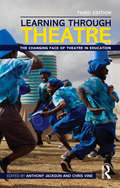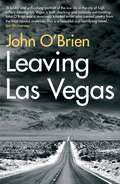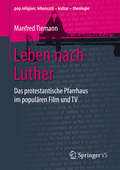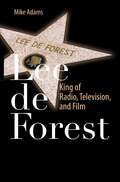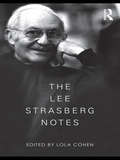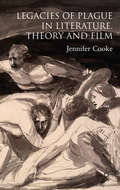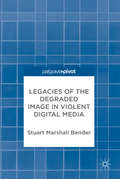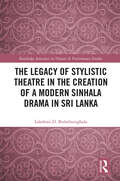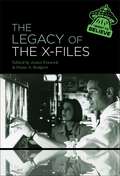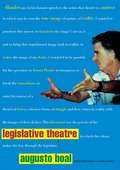- Table View
- List View
Learning How to Fall: Art and Culture after September 11
by T Nikki Cesare SchotzkoBeginning with Richard Drew’s controversial photograph of a man falling from the North Tower of the World Trade Center on September 11, Learning How to Fall investigates the changing relationship between world events and their subsequent documentation, asking: Does the mediatization of the event overwhelm the fact of the event itself? How does the mode by which information is disseminated alter the way in which we perceive such information? How does this impact upon our memory of an event? T. Nikki Cesare Schotzko posits contemporary art and performance as not only a stylized re-envisioning of daily life but, inversely, as a viable means by which one might experience and process real-world political and social events. This approach combines two concurrent and contradictory trends in aesthetics, narrative, and dramaturgy: the dramatization of real-world events so as to broaden the commercial appeal of those events in both mainstream and alternative media, and the establishment of a more holistic relationship between politically and aesthetically motivated modes of disseminating and processing information. By presenting engaging and diverse case studies from both the art world and popular culture – including Aliza Shvarts’s censored senior thesis at Yale University, Kerry Skarbakka’s provocative photographs of falling, Didier Morelli’s crawl through Toronto, and Aaron Sorkin’s The Newsroom – Learning How to Fall creates a new understanding of the relationship between the event and its documentation, where even the truth of an event might be called into question.
Learning Senegalese Sabar: Dancers and Embodiment in New York and Dakar (Dance and Performance Studies #6)
by Eleni BizasBased on extensive ethnographic fieldwork in New York and Dakar, this book explores the Senegalese dance-rhythms Sabar from the research position of a dance student. It features a comparative analysis of the pedagogical techniques used in dance classes in New York and Dakar, which in turn shed light on different aesthetics and understandings of dance, as well as different ways of learning, in each context. Pointing to a loose network of teachers and students who travel between New York and Dakar around the practice of West African dance forms, the author discusses how this movement is maintained, what role the imagination plays in mobilizing participants and how the ‘cultural flow’ of the dances is ‘punctuated’ by national borders and socio-economic relationships. She explores the different meanings articulated around Sabar’s transatlantic movement and examines how the dance floor provides the grounds for contested understandings, socio-economic relationships and broader discourses to be re-choreographed in each setting.
Learning Through Theatre: The Changing Face of Theatre in Education
by Anthony Jackson Chris VineIn the two decades since the publication of the second edition, Learning Through Theatre has further established itself as an indispensable resource for scholars, practitioners and educators interested in the complex interrelations between teaching and learning, the performing arts, and society at large. Theatre in Education (TIE) has consistently been at the cutting edge of the ever-growing field of Applied Theatre; this comprehensively revised new edition makes an international case for why, and how, it will continue to shape ways in which the participatory arts contribute to the learning of young people (and increasingly, adults) in the 21st century. Drawing on the experiences and insights of theorists and practitioners from across the world, Learning Through Theatre shows how theatre can, and does, promote: participatory engagement; the use of innovative theatrical form; work with young people and adults in a range of educational settings; and social and personal change. Now transatlantically edited by Anthony Jackson and Chris Vine, Learning Through Theatre offers exhilarating new reflections on the book’s original aim: to define, describe and debate the salient features, and wider political context, of one of the most important – and radical – developments in contemporary theatre.
Learning Through Theatre: The Changing Face of Theatre in Education
by Chris Vine Anthony JacksonIn the two decades since the publication of the second edition, Learning Through Theatre has further established itself as an indispensable resource for scholars, practitioners and educators interested in the complex interrelations between teaching and learning, the performing arts, and society at large. Theatre in Education (TIE) has consistently been at the cutting edge of the ever-growing field of Applied Theatre; this comprehensively revised new edition makes an international case for why, and how, it will continue to shape ways in which the participatory arts contribute to the learning of young people (and increasingly, adults) in the 21st century. Drawing on the experiences and insights of theorists and practitioners from across the world, Learning Through Theatre shows how theatre can, and does, promote: participatory engagement; the use of innovative theatrical form; work with young people and adults in a range of educational settings; and social and personal change. Now transatlantically edited by Anthony Jackson and Chris Vine, Learning Through Theatre offers exhilarating new reflections on the book’s original aim: to define, describe and debate the salient features, and wider political context, of one of the most important – and radical – developments in contemporary theatre.
Learning with the Lights Off: Educational Film in the United States
by Devin Orgeron Marsha Orgeron Dan StreibleA vastly influential form of filmmaking seen by millions of people, educational films provide a catalog of twentieth century preoccupations and values. As a medium of instruction and guidance, they held a powerful cultural position, producing knowledge both inside and outside the classroom. This is the first collection of essays to address this vital phenomenon. The book provides an ambitious overview of educational film practices, while each essay analyzes a crucial aspect of educational film history, ranging from case studies of films and filmmakers to broader generic and historical assessments. Offering links to many of the films, Learning With the Lights Off provides readers the context and access needed to develop a sophisticated understanding of, and a new appreciation for, a much overlooked film legacy.
Leaving Las Vegas: Stormy Monday, Liebestraum, Leaving Las Vegas (Collected Screenplays Ser.)
by Mike FiggisBen Sanderson is an alcoholic who has hit rock bottom. Cutting all personal and professional ties to his L.A. existence, he sets off for the lights of Vegas on a mission: to drink himself to death. There he meets Sera, a beautiful, seen-it-all hooker. From the moment Ben and Sera connect, they form a unique bond based upon unconditional acceptance and mutual respect that will change each of them forever. In the words of David Thompson of Los Angeles Magazine, Leaving Las Vegas is a masterpiece. Best Actor Oscar (R) winner Nicolas Cage and Best Actress nominee Elisabeth Shue set the screen ablaze in this profoundly moving love story. Nominated for two additional Academy Awards (R), Director and Adapted Screenplay, this emotionally charged powerhouse of a film graced over 100 '10 Best' lists including Roger Ebert's #1 Movie of the Year.
Leaving Las Vegas
by John O'BrienA re-issue of John O'Brien's debut novel, a masterpiece of modern realism about the perils of addiction and love in a city of loneliness.Leaving Las Vegas, the first novel by John O'Brien, is the disturbing and emotionally wrenching story of a woman who embraces life and a man who rejects it. Sera is a prostitute, content with the independence and routine she has carved out for herself in a city defined by recklessness. But she is haunted by a spectre in a yellow Mercedes, a man from her past who is committed to taking control of her life again. Ben is an alcoholic intent on drinking his way towards an early death. Newly arrived from Los Angeles, he survived the four-hour intoxicated drive across the desert with his entire savings in his wallet and nothing else left to lose. Looking to satisfy hungers both material and existential, Ben and Sera stumble together on the strip and discover in each other a respite from their unforgiving lives. A testimony to the raw talent of its young author, Leaving Las Vegas is a compelling story of unconditional love between two disenfranchised and lost souls - an overlooked American classic.
Lebanese Cinema: Imagining the Civil War and Beyond (World Cinema)
by Lina KhatibModern Lebanese cinema can best be explored in the context of the Civil War, in part because almost all the Lebanese films made since its outset in 1975 have been about this war. Lina Khatib takes 1975 Beirut as her starting point, and takes us right through to today for this, the first major book on Lebanese cinema and its links with politics and national identity.She examines how Lebanon is imagined in such films as Jocelyn Saab's 'Once Upon a Time, Beirut', Ghassan Salhab's 'Terra Incognita', and Ziad Doueiri's 'West Beirut'. In so doing, she re-examines the importance of cinema to the national imagination. Also, and using interviews with the current generation of Lebanese filmmakers, she uncovers how in the Lebanese context cinema can both construct and communicate a national identity and thereby opens up new perspectives on the socio-political role of cinema in the Arab world.CONTENTSIntroduction: On Lebanese Cinema and National Identity1 The Lebanese Cinema Industry in Context2 Religion, Conflict and the Other Within3 War as a Masculine Arena4 Women, the Body and the City5 The Politics of Place, Exile and Belonging6 History and the Avoidance of HistoryEpilogue: Imagining the Nation - Notes, Bibliography, Filmography,Index
Leben nach Luther: Das protestantische Pfarrhaus im populären Film und TV (pop.religion: lebensstil – kultur – theologie)
by Manfred TiemannDieses Buch geht zunächst auf die Präsenz von Kirche in Medien und auf unterschiedliche Darstellungen „Die Luthers im Pfarrhaus“ ein. Anschließend wird das Medium Pfarrer-Film (1910-2017) mit seinen verschiedenen Ausprägungen und Themenfeldern, Wirkungen und Möglichkeiten der Auseinandersetzung in den Blick genommen. Die ausführliche Darstellung von 53 Einzelbeispielen mit Interpretationen, Schlüsselszenen und Bewertungen bilden den Kern des Buches.
Lee Brilleaux: Rock"n"Roll Gentleman: The Adventures of Dr Feelgood's Iconic Frontman
by Zoë HoweLee Brilleaux, the uniquely charismatic star of proto-punk R&B reprobates Dr Feelgood, was one of rock’n’roll’s greatest frontmen. But he was also one of its greatest gentlemen - a class act with heart, fire, wanderlust and a wild streak. Exploding out of Canvey Island in the early 1970s - an age of glam rock, post-hippy folk and pop androgyny - the Feelgoods, with Lee Brilleaux and Wilko Johnson at the helm, charged into London, grabbed the pub rock scene by the throat and sparked a revolutionary new era, proving that you didn’t have to be middle class, wearing the ‘right clothes’ or living in the ‘right place’ to succeed. Lee Brilleaux: Rock’n’Roll Gentleman, while a totally different work, is a companion of sorts to the hugely popular Wilko Johnson book: Looking Back At Me (also co-authored by Howe). It is the first comprehensive appreciation of Lee Brilleaux and, with its numerous exclusive interviews and previously unseen images, is a book no Dr Feelgood fan would wish to be without.
Lee de Forest: King of Radio, Television, and Film
by Mike AdamsThe life-long inventor, Lee de Forest invented the three-element vacuum tube used between 1906 and 1916 as a detector, amplifier, and oscillator of radio waves. Beginning in 1918 he began to develop a light valve, a device for writing and reading sound using light patterns. While he received many patents for his process, he was initially ignored by the film industry. In order to promote and demonstrate his process he made several hundred sound short films, he rented space for their showing; he sold the tickets and did the publicity to gain audiences for his invention. Lee de Forest officially brought sound to film in 1919. Lee De Forest: King of Radio, Television, and Film is about both invention and early film making; de Forest as the scientist and producer, director, and writer of the content. This book tells the story of de Forest’s contribution in changing the history of film through the incorporation of sound. The text includes primary source historical material, U.S. patents and richly-illustrated photos of Lee de Forest’s experiments. Readers will greatly benefit from an understanding of the transition from silent to audio motion pictures, the impact this had on the scientific community and the popular culture, as well as the economics of the entertainment industry.
The Lee Strasberg Notes
by Lola CohenThe Lee Strasberg Notes reproduces the original teachings of a unique voice in actor training, for the very first time. It is a stunning document in the history and ongoing practice of Strasberg’s Method. Compiled and edited by Lola Cohen, the book is based on unpublished transcripts of Strasberg’s own classes on acting, directing and Shakespeare. It recreates his theoretical approach, as well as the practical exercises used by his students, and brilliantly conveys his approach and personality. The book features Strasberg’s teachings on: • Training and exercises • Characters and scenes • Directing and the Method • Shakespeare and Stanislavski • The theater, acting and actors. Including a Preface by Anna Strasberg and a Foreword by Martin Sheen, this illuminating book brings the reader closer to Strasberg’s own methods than any other, making it a phenomenal resource for students, actors, and directors.
The Lee Strasberg Notes
by Lola CohenThe Lee Strasberg Notes reproduces the original teachings of a unique voice in actor training, for the very first time. It is a stunning document in the history and ongoing practice of Strasberg’s Method. Compiled and edited by Lola Cohen, the book is based on unpublished transcripts of Strasberg’s own classes on acting, directing and Shakespeare. It recreates his theoretical approach, as well as the practical exercises used by his students, and brilliantly conveys his approach and personality. The book features Strasberg’s teachings on: • Training and exercises • Characters and scenes • Directing and the Method • Shakespeare and Stanislavski • The theater, acting and actors. Including a Preface by Anna Strasberg and a Foreword by Martin Sheen, this illuminating book brings the reader closer to Strasberg’s own methods than any other, making it a phenomenal resource for students, actors, and directors.
Legacies of Plague in Literature, Theory and Film
by J. CookeThis book is an account of the history and continuation of plague as a potent metaphor since the disease ceased to be an epidemic threat in Western Europe, engaging with twentieth-century critiques of fascism, anti-Semitic rhetoric, the Oedipal legacy of psychoanalysis and its reception, and film spectatorship and the zombie genre.
Legacies of the Degraded Image in Violent Digital Media
by Stuart Marshall BenderThis book undertakes a concentrated study of the impact of degraded and low-quality imagery in contemporary cinema and real-world portrayals of violence. Through a series of case studies, the book explores examples of corrupted digital imagery that range from mainstream cinema portrayals of drone warfare and infantry killing, through to real-world recordings of terrorist attacks and executions, as well as perpetrator-created murder videos live-streamed on the internet. Despite post-modernist concerns of cultural inurement during the seminal period of digitalized and virtualized killing in the 1990s, real-world reactions to violent media indicate that our culture is anything but desensitized to these media depictions. Against such a background, this book is a concentrated study of how these images are created and circulated in the contemporary media landscape and how the effect and affect of violent material is impacted by the low-resolution aesthetic.
Legacies of the Degraded Image in Violent Digital Media
by Stuart Marshall BenderThis book undertakes a concentrated study of the impact of degraded and low-quality imagery in contemporary cinema and real-world portrayals of violence. Through a series of case studies, the book explores examples of corrupted digital imagery that range from mainstream cinema portrayals of drone warfare and infantry killing, through to real-world recordings of terrorist attacks and executions, as well as perpetrator-created murder videos live-streamed on the internet. Despite post-modernist concerns of cultural inurement during the seminal period of digitalized and virtualized killing in the 1990s, real-world reactions to violent media indicate that our culture is anything but desensitized to these media depictions. Against such a background, this book is a concentrated study of how these images are created and circulated in the contemporary media landscape and how the effect and affect of violent material is impacted by the low-resolution aesthetic.
The Legacy of Mad Men: Cultural History, Intermediality and American Television
by Karen McNally Jane Marcellus Teresa Forde Kirsty Fairclough“The Legacy of Mad Men adds significant new perspectives to the legacy of Mad Men scholarship. The authors apply theoretical perspectives that have been understudied in previous Mad Men work, chart new connections with previous media, and examine overlooked aspects of Men Men’s sound design. A concluding chapter insightfully considers how the election of Donald Trump has signaled a resurgence in the sexism, antisemitism, and racism critiqued in Mad Men.”- - Dr Jeremy Butler, Professor of Communication and Culture, University of Alabama For seven seasons, viewers worldwide watched as ad man Don Draper moved from adultery to self-discovery, secretary Peggy Olson became a take-no-prisoners businesswoman, object-of-the-gaze Joan Holloway developed a feminist consciousness, executive Roger Sterling tripped on LSD, and smarmy Pete Campbell became a surprisingly nice guy. Mad Men defined a pivotal moment for television, earning an enduring place in the medium’s history. This edited collection examines the enduringly popular television series as Mad Men still captivates audiences and scholars in its nuanced depiction of a complex decade. This is the first book to offer an analysis of Mad Men in its entirety, exploring the cyclical and episodic structure of the long form series and investigating issues of representation, power and social change. The collection establishes the show’s legacy in televisual terms, and brings it up to date through an examination of its cultural importance in the Trump era. Aimed at scholars and interested general readers, the book illustrates the ways in which Mad Men has become a cultural marker for reflecting upon contemporary television and politics.
The Legacy of Stylistic Theatre in the Creation of a Modern Sinhala Drama in Sri Lanka (ISSN)
by Lakshmi D. BulathsinghalaThis book explores the development of Sinhala stylistic drama from its earliest manifestations to the post-independence era.Bulathsinghala examines the impact of indigenous and imported folk theatrical forms on the work of the most significant postcolonial stylistic dramatists and on key plays that they produced. In the process, the book explores a number of myths and misunderstandings regarding Sri Lanka’s folk heritage and seeks to establish more reliable information on the principal indigenous Sri Lankan folk dramatic forms and their characteristics. At the same time, by drawing connections between folk drama and the post-independence stylistic theatrical movement, the author demonstrates the essential role of the former in Sinhala culture prior to the advent of Western and other influences and shows how both continue to inflect Sri Lankan drama today.This book will help to open the field of South Asian drama studies to an audience consisting not only of scholars and students but also of general readers who are interested in the fields of drama and theatre and Asian studies.
The Legacy of Stylistic Theatre in the Creation of a Modern Sinhala Drama in Sri Lanka (ISSN)
by Lakshmi D. BulathsinghalaThis book explores the development of Sinhala stylistic drama from its earliest manifestations to the post-independence era.Bulathsinghala examines the impact of indigenous and imported folk theatrical forms on the work of the most significant postcolonial stylistic dramatists and on key plays that they produced. In the process, the book explores a number of myths and misunderstandings regarding Sri Lanka’s folk heritage and seeks to establish more reliable information on the principal indigenous Sri Lankan folk dramatic forms and their characteristics. At the same time, by drawing connections between folk drama and the post-independence stylistic theatrical movement, the author demonstrates the essential role of the former in Sinhala culture prior to the advent of Western and other influences and shows how both continue to inflect Sri Lankan drama today.This book will help to open the field of South Asian drama studies to an audience consisting not only of scholars and students but also of general readers who are interested in the fields of drama and theatre and Asian studies.
The Legacy of the New Wave in French Cinema
by Douglas MorreyIn this study of the impact and influence of the New Wave in French cinema, Douglas Morrey looks at both the subsequent careers of New Wave filmmakers and the work of later film directors and film movements in France. This book is organized around a series of key moments from the past 50 years of French cinema in order to show how the meaning and legacy of the New Wave have shifted over time and how the priorities, approaches and discourses of filmmakers and film critics have changed over the years. Morrey tackles key concepts such as the auteur, the relationship of form and content, gender and sexuality, intertextuality and rhythm. Filmmakers discussed include Godard, Truffaut, Varda, Chabrol and Rohmer plus Philippe Garrel, Luc Besson, Leos Carax, Bruno Dumont, the Dardenne brothers, Christophe Honoré, François Ozon and Jacques Audiard.
The Legacy of the New Wave in French Cinema
by Douglas MorreyIn this study of the impact and influence of the New Wave in French cinema, Douglas Morrey looks at both the subsequent careers of New Wave filmmakers and the work of later film directors and film movements in France. This book is organized around a series of key moments from the past 50 years of French cinema in order to show how the meaning and legacy of the New Wave have shifted over time and how the priorities, approaches and discourses of filmmakers and film critics have changed over the years. Morrey tackles key concepts such as the auteur, the relationship of form and content, gender and sexuality, intertextuality and rhythm. Filmmakers discussed include Godard, Truffaut, Varda, Chabrol and Rohmer plus Philippe Garrel, Luc Besson, Leos Carax, Bruno Dumont, the Dardenne brothers, Christophe Honoré, François Ozon and Jacques Audiard.
The Legacy of The X-Files
by James FenwickThe Legacy of The X-Files examines the content and production of the show, its reception, its use of legend and folklore, its contemporary resonance in politics and society of the 21st century, and its impact and legacy on film, television, the Internet and beyond. Having converged with the early widespread use of the Internet, The X-Files became a cultural touchstone of the 1990s, transforming from a cult TV show into a pop cultural phenomenon by the end of the decade. To celebrate the 30th anniversary of The X-Files, this collection examines the content and production of the show, its reception, its use of legend and folklore, its contemporary resonance in politics and society of the 21st century, and its impact and legacy on film, television, the Internet and beyond. The series' themes of government mistrust, conspiracy, folklore, UFOlogy, and faith are dissected and applied to how the show spirituality resonated with post-Cold War Western society.Contributors to this collection discuss the wide-ranging impact of the television show in popular culture, from Mulder and Scully 'shippers' to the show's slogan entering the contemporary lexicon. The Legacy of The X-Files serves as an all-encompassing, multi-disciplinary, contemporary account of The X-Files, reflecting upon critical, historical, political, and social contexts, and featuring an in-depth and comprehensive introduction making it a vital work for researchers and students alike.
The Legacy of The X-Files
The Legacy of The X-Files examines the content and production of the show, its reception, its use of legend and folklore, its contemporary resonance in politics and society of the 21st century, and its impact and legacy on film, television, the Internet and beyond. Having converged with the early widespread use of the Internet, The X-Files became a cultural touchstone of the 1990s, transforming from a cult TV show into a pop cultural phenomenon by the end of the decade. To celebrate the 30th anniversary of The X-Files, this collection examines the content and production of the show, its reception, its use of legend and folklore, its contemporary resonance in politics and society of the 21st century, and its impact and legacy on film, television, the Internet and beyond. The series' themes of government mistrust, conspiracy, folklore, UFOlogy, and faith are dissected and applied to how the show spirituality resonated with post-Cold War Western society.Contributors to this collection discuss the wide-ranging impact of the television show in popular culture, from Mulder and Scully 'shippers' to the show's slogan entering the contemporary lexicon. The Legacy of The X-Files serves as an all-encompassing, multi-disciplinary, contemporary account of The X-Files, reflecting upon critical, historical, political, and social contexts, and featuring an in-depth and comprehensive introduction making it a vital work for researchers and students alike.
The Legal Thriller from Gardner to Grisham: See you in Court! (Crime Files)
by Lars Ole SauerbergThis book offers a critically informed yet relaxed historical overview of the legal thriller, a unique contribution to crime fiction where most of the titles have been written by professionals such as lawyers and judges.The legal thriller typically uses court trials as the suspense-creating background for presenting legal issues reflecting a wide range of concerns, from corporate conflicts to private concerns, all in a dramatic but highly informed manner. With authors primarily from the USA and the UK, the genre is one which nonetheless enjoys a global reading audience. As well as providing a survey of the legal thriller, this book takes a gender–focused approach to analyzing recently published titles within the field. It also argues for the fascination of the legal thriller both in the way its narrative pattern parallels that of an actual court trial, and by the way it reflects, frequently quite critically, the concerns of contemporary society.
Legislative Theatre: Using Performance to Make Politics
by Augusto BoalAugusto Boal's reputation is now moving beyond the realms of theatre and drama therapy, bringing him to the attention of a wider public. Legislative Theatre is the latest and most remarkable stage in his work. 'Legislative Theatre' is an attempt to use Boal's method of 'Forum Theatre' within a political system to create a truer form of democracy. It is an extraordinary experiment in the potential of theatre to affect social change. At the heart of his method of Forum Theatre is the dual meaning of the verb 'to act': to perform and to take action. Forum Theatre invites members of the audience to take the stage and decide the outcome, becoming an integral part of the performance. As a politician in his native Rio de Janeiro, Boal used Forum Theatre to motivate the local populace in generating relevant legislation. In Legislative Theatre Boal creates new, theatrical, and truly revolutionary ways of involving everyone in the democratic process. This book includes: * a full explanation of the genesis and principles of Legislative Theatre * a description of the process in operation in Rio * Boal's essays, speeches and lectures on popular theatre, Paolo Freire, cultural activism, the point of playwrighting, and much else besides.


